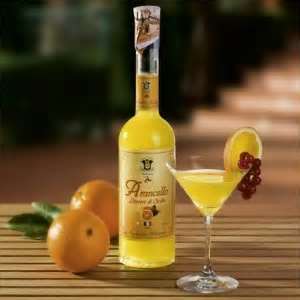The terms liqueur, schnapps, anise, and bitters refer to a variety of flavored spirits. Such products are made from distilled alcohol flavored with fruit, cream, herbs, spices, flowers, seeds, roots, barks, or nuts and bottled with added sugar. They usually have an alcohol content of 15%-30%.
LIQUEUR
 Liqueurs are produced either by distilling fermented flavor ingredients or by distilling the spirit in which flavorings have been soaked for several days. Some liqueurs begin with finished spirits such as brandy, cognac, rum, or whiskey to which flavorings are added. Others begin by adding fruit and flavorings to a neutral spirit. Liqueurs are usually not aged very long but may have resting stages during production to allow flavors to blend.
Liqueurs are produced either by distilling fermented flavor ingredients or by distilling the spirit in which flavorings have been soaked for several days. Some liqueurs begin with finished spirits such as brandy, cognac, rum, or whiskey to which flavorings are added. Others begin by adding fruit and flavorings to a neutral spirit. Liqueurs are usually not aged very long but may have resting stages during production to allow flavors to blend.
Generic liqueurs, such as amaretto or curacao, have no specific formula and can be made by any producer. Proprietary liqueurs are those with trademarked names and often secret recipes such as Midori or Grand Marnier.
Examples of the many types of liqueurs include berry (Chambord), chocolate (Godiva), coffee (Kahlua), flower (Crème de violette), fruit (Cointreau), plant (Benedictine), herbal (Galliano), honey (Drambuie), whiskey (Rock and Rye), and nut-flavored (Frangelico).
Crèmes are liqueurs with a single dominant flavor such as crème de menthe (mint), crème de cacao (chocolate), and crème de cassis (black currant).
Cream liqueurs such as Baileys Irish Cream (which uses Irish whiskey) and Heather Cream (which uses Scotch) combine dairy cream and alcohol into a homogenized, shelf-stable blend.
Liqueurs (sometimes called cordials) may be served straight, poured over ice, combined with other ingredients into a variety of cocktails, or used as flavoring in coffee or desserts.
SCHNAPPS
This term refers to an assortment of clear and flavored spirits that originated in northern regions such as Germany or Scandinavia. Schnapps can be made from grain, potatoes, or molasses and flavored with nearly anything. The product is similar in style to flavored vodka but different in preparation because sugar is added. Principal fruits used for German schnapps are apples, pears, plums, cherries, and (in Austria) apricots. American schnapps are made in dozens of flavors ranging from banana and butterscotch to root beer and watermelon.
ANISE
Spirits flavored with anise vary with the country of origin. They can be dry or sweet, high or low in alcohol, distilled from fermented aniseed or made from anise steeped in a neutral spirit. In France, Pernod produces Anis by distilling a blend of anise and other botanicals. In Italy, Sambuca is distilled from anise and botanicals then heavily sweetened. Greece produces a drier spirit called Ouzo made from pressed grapes, berries, and herbs including aniseed, licorice, mint, wintergreen, fennel, and hazelnut. Absinthe is also anise-flavored but is liquor, not liqueur, because it is not sweetened.
BITTERS
Bitters are descendants of medieval medical potions and are marketed as having some minor therapeutic value as stomach settlers or hangover cures. They are made by flavoring alcohol with herbs, roots, and a variety of botanicals. Bitters contain less fruit and sugar than liqueurs and taste, as the name implies, bitter. They are popular cocktail ingredients used to reduce a drink’s sweetness and add an herbal flavor.
